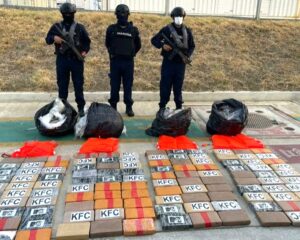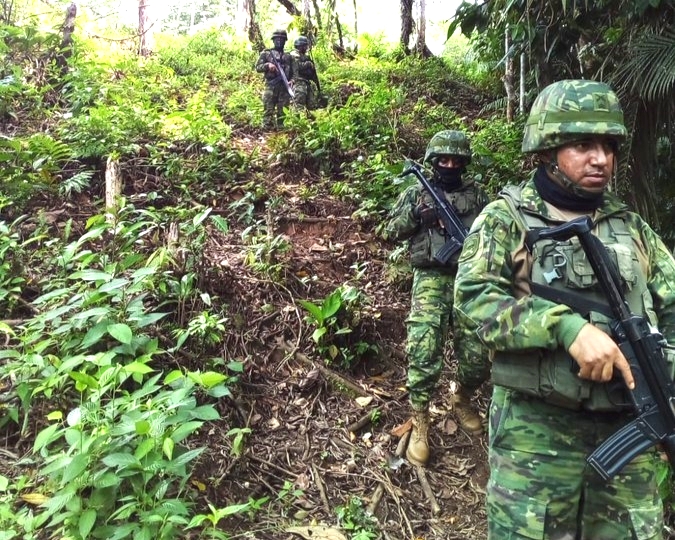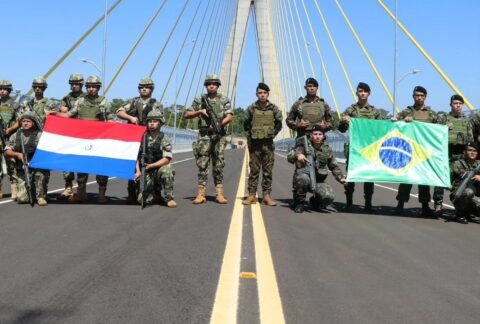Faced with the growing presence of illegal armed groups on the Colombian-Ecuadorian border, the Ecuadorian Armed Forces intensified security and controls in the region to prevent these groups from crossing into Ecuadorian territory, the Ecuadorian Armed Forces’ Joint Command said via Twitter.
“Our mission is to guard the border, the towns. We have located the illegal border crossings through which they usually go through; they are jungle, quite porous and difficult to control,” Ecuadorian Army Brigadier General Alexander Levoyer, commander of the Esmeraldas Joint Task Force, told Diálogo on September 18. “We are continuously patrolling.”
According to authorities, this is directly related to the surge in cocaine production and trafficking from Colombia, with consequences ranging from increased demand for logistics to get the alkaloid out to an increase in the supply of precursors, Ecuadorian daily El Comercio reported on August 26.
The Ecuadorian security forces have identified massive movement of devices, supplies, fuel, chemicals, and packages containing narcotics, many of which have been seized by the military and police. In addition, authorities reported the emergence of criminal groups linked to Colombian dissident groups at the border crossings of Mataje, Esmeraldas, and Tobar Donoso, in the province of Carchi. According to El Comercio, these groups provide support to narcotraffickers to move drug shipments and exercise territorial control.
Several of these criminal groups receive cocaine shipments from the Oliver Sinisterra Front, the Urías Rendón Mobile Column, and the so-called Comandos de la Frontera, dissident groups of the Revolutionary Armed Forces of Colombia, reported Ecuadorian newspaper Primicias.
Special security

For the Ecuadorian Armed Forces, “all borders are of high interest. All the provinces are being hit by narcotrafficking,” Brig. Gen. Levoyer said. “We have prioritized the province of Esmeraldas because of its strategic position.”
Esmeraldas “is the shortest exit for the Mexican cartels that go through Colombia and intend to enter Ecuadorian territory, and move drugs for their commercialization,” he added. “We’ve declared it a special security zone.”
Brig. Gen. Levoyer also said that more than 1,400 military personnel are deployed in conflict zones of Esmeraldas, to stop the violence criminal gangs linked to narcotrafficking have unleashed.
Records of violent deaths are high. Between July and September 2021, there were an average of 11 violent deaths per month. During the same time period in 2022 they shot up to 40, Brig. Gen. Levoyer said. “These are violent deaths related to hired killings,” he added.
In Esmeraldas there are now four battalions and a military intelligence unit, Brig. Gen. Levoyer said. A significant amount of land, naval, and air resources have also been assigned to the region.
“We want to adequately confront […] narcotrafficking. In this province the illegal armed groups are trying to come through, but we are there to hold them back and fight. In the last three months we have had combat encounters on five occasions,” he said.
Making a move
To strengthen actions against threats on the Colombian-Ecuadorian border, the Ecuadorian Armed Forces intensified military inspections, reconnaissance, and surveillance patrols, as well as operations in support of integral security and national development, reports the U.S. Army magazine Military Review.
“We are putting pressure [on criminal organizations]. We are working morning, noon, and night on aerial reconnaissance. We are [preventing] them from leaving the territorial sea with our vessels. With the presence of our corvettes we are making a move against narcotraffickers and we are blocking their exits through the estuaries,” Brig. Gen. Levoyer said.
Between January and August 2022, security forces seized 140 tons of drugs, the Ecuadorian National Police said via Twitter. Ecuador is the third country with the highest volume of drug seizures, behind Colombia and the United States, Spanish news agency EFE reported.
Key player
Narcotrafficking is crucial as part of the strategy against narcotrafficking, Brig. Gen. Levoyer said. “The United States is a key player in this frontal fight against narcotrafficking. We are in a real war against narcotrafficking, a real fight, and here the U.S. plays a fundamental role.”
In this context, the U.S. government supports the Ecuadorian Armed Forces with technology, resources, training, and information exchange. “U.S. cooperation on these border security issues, a regional issue, benefits the country and the region,” he added.
In addition, the U.S. and Colombia, another strategic partner, have an important tool at their disposal: military and police intelligence. “Managing information and intelligence is power,” concluded Brig. Gen. Levoyer. “Ecuador is always exchanging information and intelligence with these two countries.”









